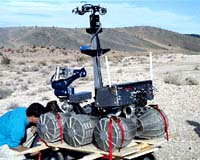| . |  |
. |
 San Francisco - December 13, 1999 - Analyses performed on a sliver of terrestrial rock by the Department of Energy's Los Alamos National Laboratory may one day help researchers better understand the makeup of large extraterrestrial bodies such as Mars, comets and asteroids.
San Francisco - December 13, 1999 - Analyses performed on a sliver of terrestrial rock by the Department of Energy's Los Alamos National Laboratory may one day help researchers better understand the makeup of large extraterrestrial bodies such as Mars, comets and asteroids.Using Los Alamos-developed laser-induced breakdown spectroscopy, the researchers demonstrated they can account for weather-induced surfaces on terrestrial rocks and identify the true, pristine elemental compositions beneath. The researchers explained their results today during the fall meeting of the American Geophysical Union in San Francisco. The work was sponsored by NASA's Mars Instrument Development Program, now in its second year. "It's very likely that Mars has some kind of weathering process on its surface, so we need to account for that in our future analyses of rocks and other samples from Mars," said Roger Wiens of Los Alamos' Space and Atmospheric Sciences Group. "Prior analyses of Mars by instruments on NASA's Viking and Pathfinder didn't take weathering conditions into account." Los Alamos has been developing the LIBS technology since 1981. A laser strikes samples of soil, air or water, evaporating the sample to form a hot microplasma and exciting the atoms to emit light. LIBS is based on the fact that all elements have unique spectral signatures. By analyzing the spectra of the emitted light, LIBS can determine the sample's composition within minutes, even at concentrations as low as two parts per million. LIBS is more sensitive than other elemental analytical tools such as X-ray fluorescence and alpha proton X-ray spectroscopy. In addition, LIBS does not need to make direct contact with the sample; the laser can strike it from as far away as 22 yards. The technology has won three prestigious R&D 100 awards from R&D magazine over the years and has been commercialized for various applications. In their recent studies, Los Alamos researchers used LIBS to determine the composition of a rock sample from California's Mojave Desert. The rock's surface had a thick mineral varnish deposited on it by the desert's natural weather environment. "Desert varnish can be up to half a millimeter thick. It contains manganese and clay minerals, which did not come from the rock. This means the varnish had to have been deposited on the rock through some kind of atmospheric phenomenon," Wiens said. The researchers took the sample, which weighed less than 100 grams, and broke it into several pieces. The places where the samples were broken contained no varnish. The researchers then illuminated the samples' varnished and unvarnished areas with the laser from about 10 feet away. "Our results showed that LIBS 'bored through' the varnished areas and obtained the same elemental composition measurements as the unvarnished areas," said Wiens. The researchers are building a prototype rover-based LIBS instrument for field tests in the Mojave Desert scheduled for May. Wiens and his colleagues also are hoping to adapt LIBS for landing crafts to perform remote elemental analyses of comets and asteroids. The Los Alamos research team consists of project leader David Cremers and colleague Monty Ferris of the American Chemical Diagnostics and Instrumentation Group; Wiens and Space and Atmospheric Sciences Group colleague Jane Nordholt; Jim Blacic of the Geoengineering Group; and Nathan Miller of the Science and Technology Base Programs Office. Horton Newsom of the geology department at the University of New Mexico also was a co-author on this work.
Lasers At SpaceDaily
|
| |||||||||
| The content herein, unless otherwise known to be public domain, are Copyright 1995-2016 - Space Media Network. All websites are published in Australia and are solely subject to Australian law and governed by Fair Use principals for news reporting and research purposes. AFP, UPI and IANS news wire stories are copyright Agence France-Presse, United Press International and Indo-Asia News Service. ESA news reports are copyright European Space Agency. All NASA sourced material is public domain. Additional copyrights may apply in whole or part to other bona fide parties. Advertising does not imply endorsement, agreement or approval of any opinions, statements or information provided by Space Media Network on any Web page published or hosted by Space Media Network. Privacy Statement All images and articles appearing on Space Media Network have been edited or digitally altered in some way. Any requests to remove copyright material will be acted upon in a timely and appropriate manner. Any attempt to extort money from Space Media Network will be ignored and reported to Australian Law Enforcement Agencies as a potential case of financial fraud involving the use of a telephonic carriage device or postal service. |